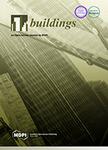版权所有:内蒙古大学图书馆 技术提供:维普资讯• 智图
内蒙古自治区呼和浩特市赛罕区大学西街235号 邮编: 010021

作者机构:Xian Univ Architecture & Technol Sch Civil Engn Xian 710055 Peoples R China Xijing Univ Sch Civil Engn Xian 710123 Peoples R China Shaanxi Key Lab Safety & Durabil Concrete Struct Xian 710123 Peoples R China
出 版 物:《BUILDINGS》 (Buildings)
年 卷 期:2022年第12卷第8期
页 面:1150页
核心收录:
基 金:Key Research and Development Program of Shaanxi [2021SF-521]
主 题:cement-based piezoelectric composites relative dynamic elastic modulus compressive strength loss rate resistivity change rate pressure sensitivity coefficient
摘 要:Under the complex working conditions in cold areas, in order to achieve health monitoring of engineering structures, carbon fiber and iron tailings sand were added to ordinary cement-based materials to prepare cement-based piezoelectric composites, and the deterioration of their pressure-sensitive properties and mechanical properties under the action of the sulfate-freeze-thaw cycle was studied. Six groups of specimens and a set of benchmark specimens were prepared according to different contents of carbon fiber and iron tailings sand, and the specimens of each group were analyzed qualitatively and quantitatively after 50, 100, and 150 freeze-thaw cycles. Based on the external damage analysis, it was concluded that with the increase in the number of freeze-thaw cycles, the apparent morphology of the specimens in each group continued to deteriorate. After 150 freeze-thaw cycles, the addition of a certain proportion of carbon fiber and iron tailings can improve the compactness of cement-based composites, effectively inhibit the development of cracks, maintain the integrity of the apparent morphology of the specimen, and the quality loss rate of the specimen does not exceed 5%. Based on the internal damage analysis, it is concluded that the specimen mixed with carbon fiber and iron tailings has undergone the freeze-thaw cycles, and its relative dynamic elastic modulus generally shows a trend of first rising and then falling, and after 150 freeze-thaw cycles, the relative dynamic elastic modulus of C04T30 specimen is 85.5%, and its compressive strength loss rate is 20.2%, indicating that its freeze resistance is optimal. The compressive stress and resistivity change rate of each group of cement-based piezoelectric composite specimens that have not undergone freeze-thaw cycles are approximately consistent with the linear attenuation relationship. Those that have undergone 150 freeze-thaw cycles approximately conform to the polynomial attenuation relationship. The correla